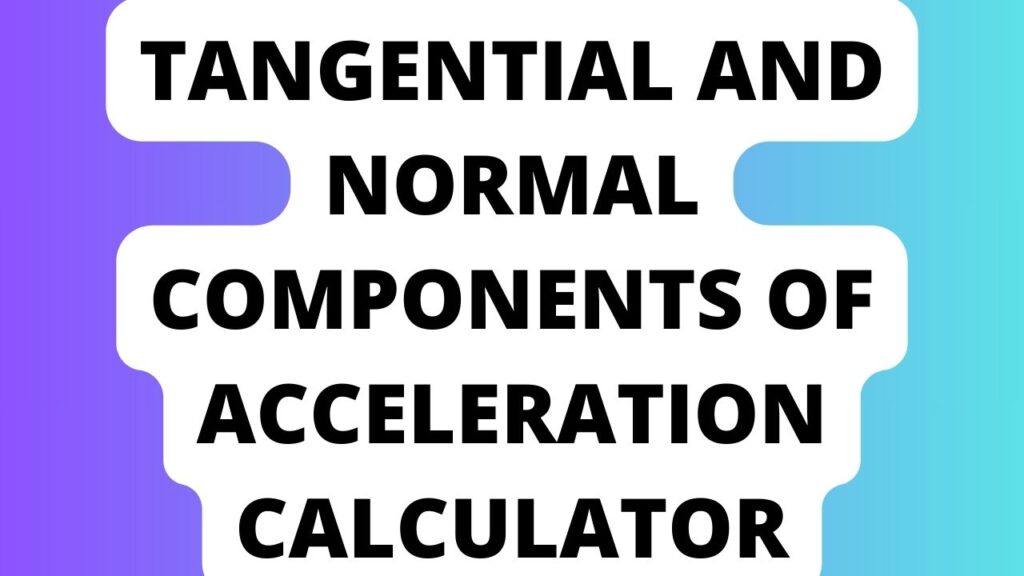I. Introduction to Acceleration
Tangential And Normal Components of Acceleration Calculator Acceleration, a fundamental concept in physics, defines the rate of change in velocity concerning time. Understanding its components – tangential and normal – unlocks profound insights into the dynamics of motion.
Understanding Acceleration
Defining Acceleration
Acceleration embodies the alteration in an object’s velocity per unit of time, denoted as meters per second squared (m/s²). It portrays how swiftly an object’s speed changes.
Types of Acceleration
Acceleration manifests in various forms, inclusive of uniform, non-uniform, tangential, and normal acceleration, each portraying distinct motion characteristics.
Acceleration Formula and Calculation
The formula for acceleration is straightforward: �=Δ�Δ�a=ΔtΔv, where �a represents acceleration, Δ�Δv signifies change in velocity, and Δ�Δt denotes change in time.
Understanding Tangential Acceleration
Tangential Acceleration Explained
Tangential acceleration signifies the rate of change of an object’s linear speed along its curved path, pivotal in circular motion dynamics.
Tangential Acceleration Formula
The formula for tangential acceleration ��=�×�at=r×α, where �r represents radius and �α denotes angular acceleration.
Real-Life Examples of Tangential Acceleration
[Continue to explore real-life examples, applications, and calculations related to tangential acceleration.]
A. Defining Acceleration
Acceleration elucidates the rate of change of an object’s velocity, expressed as the derivative of its velocity with respect to time.
B. Types of Acceleration
Explore various types, from linear to angular acceleration, unveiling diverse facets of motion in different contexts.
C. Importance of Understanding Components
Delve into why comprehending tangential and normal acceleration components is pivotal in dissecting complex motions.
II. Understanding Tangential Acceleration
Tangential acceleration occurs due to a change in the magnitude of velocity in a circular or curved path.
A. Explaining Tangential Acceleration
Unravel the essence of tangential acceleration, emphasizing its role in altering the velocity’s magnitude.
B. Formula for Tangential Acceleration
Discover the formulaic representation of tangential acceleration, shedding light on the mathematical underpinnings.
C. Examples of Tangential Acceleration
Real-world scenarios exemplifying tangential acceleration elucidate its practical significance.
III. Understanding Normal Acceleration
Normal acceleration arises from changes in the direction of an object’s velocity in a curved path.
A. Explaining Normal Acceleration
Dive into the concept of normal acceleration, elucidating its association with changes in direction.
B. Formula for Normal Acceleration
Uncover the formula for calculating normal acceleration, showcasing its relationship with motion dynamics.
C. Examples of Normal Acceleration
Explore instances exemplifying normal acceleration, illuminating its relevance in diverse contexts.

IV. Calculating Total Acceleration
Combining tangential and normal components yields the total acceleration, offering a comprehensive view of an object’s motion.
A. Combining Tangential and Normal Components
Understand the integration of tangential and normal accelerations to determine the total acceleration.
B. Formula for Total Acceleration
The mathematical representation of total acceleration reveals the synthesis of both components.
C. Real-life Applications
Real-life applications elucidate how total acceleration calculations impact various fields, from engineering to transportation.
V. Practical Uses of Acceleration Calculators
Acceleration calculators find multifaceted applications across scientific domains and real-world scenarios.
A. Engineering Applications
Explore how acceleration calculators aid in engineering design, analysis, and optimization.
B. Physics and Scientific Research
Discover their role in scientific endeavors, facilitating accurate analysis and experimentation.
C. Automotive and Transportation
Unveil their significance in automotive technology, contributing to vehicle performance and safety enhancements.
VI. How to Use an Acceleration Calculator
A step-by-step guide simplifies the utilization of acceleration calculators for precise measurements.
A. Step-by-Step Guide
Navigate through the process of using acceleration calculators, ensuring accurate results.
B. Tips for Accurate Calculations
Essential tips enhance the accuracy of calculations, optimizing the utility of these tools.
VII. Common Mistakes to Avoid
Identifying and rectifying common errors ensures precise interpretation of acceleration data.
A. Misinterpretation of Results
Highlighting potential pitfalls in interpreting acceleration data correctly.
B. Incorrect Inputs
Addressing the impact of erroneous inputs on the accuracy of calculated results.
C. Overlooking Unit Conversions
Emphasizing the significance of correct unit conversions in acceleration calculations.
VIII. FAQs about Acceleration Calculators
- What is Tangential Acceleration?
- How is Normal Acceleration Calculated?
- How are Tangential and Normal Accelerations Related?
- Why is Understanding Acceleration Important in Physics?
- Are Acceleration Calculators Accurate?
- Where Can I Find Reliable Acceleration Calculator Tools?
IX. Conclusion
Summarizing the key facets explored and encouraging further exploration into the dynamic realm of acceleration components.
